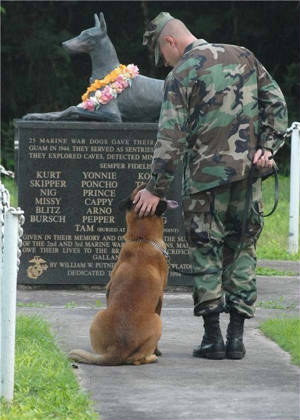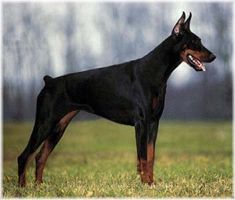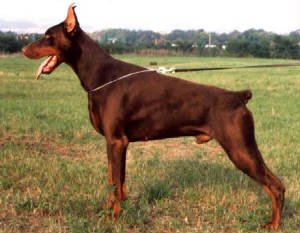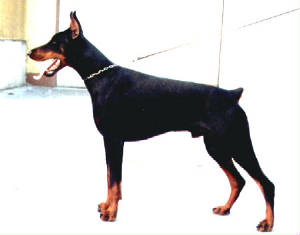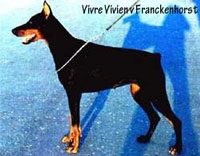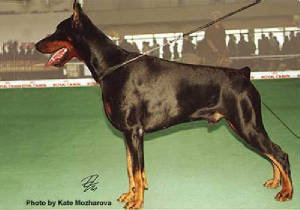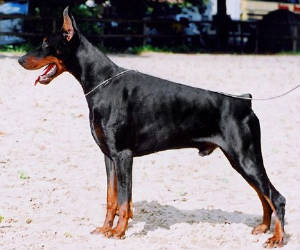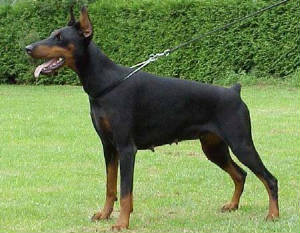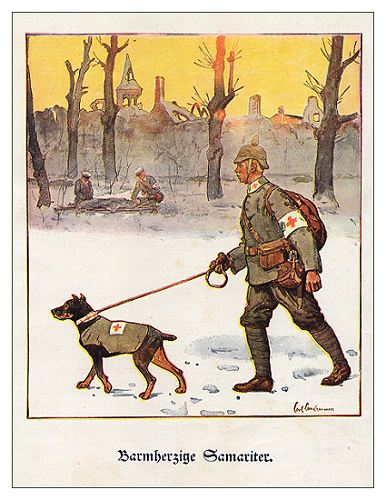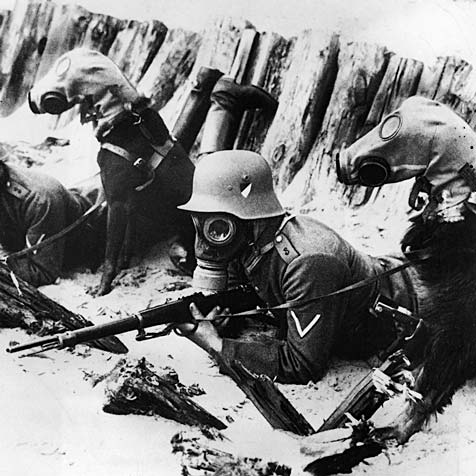|
|
|
|
Our Breed The Dobermann
|
|||||||||||||||||||||||||||||||||||||||||
|
Unfortunately there are only few biographical and written
details about Friedrich Dobermann and his breeding programs (if he had any). Many things are written about him, but little
is based on fact, and some of it quite contradictory. Friedrich Dobermann was a real countryman who was extremely fond of dogs, and he was particularly
interested in breeding. He was born on the 2nd January 1834 in a small town called Apolda, which is situated in the southern
central part of Germany. In those early days communications were bad, and the local
inhabitants of the area made their own hobbies and pleasures. One of the interests of these country people was dogs and dog
breeding, and Friedrich Dobermann was undoubtedly the leading light. Friedrich Dobermann held a number of jobs, which included
being the municipal skinner, the local dogcatcher, and the official tax collector. He was also the administrator of the "Chamber
of Accounts", and at night he seems to have been police officer and possibly at one time a night watchman. Many of these jobs
were extremely suitable for his pastime of dog breeding. As a skinner in the local slaughterhouse he could obtain cheap food
for his dogs, and as the local dogcatcher he could probably acquire dogs that were suitable for his breeding purposes. For
his night watchman and police work he obviously required a good dog with courage, hardness and a highly developed protective
instinct to accompany him on his rounds. The first female dogs that Friedrich Dobermann used for breeding was called "Bissart"
(black with tan markings, grey undercoat) and "Schnuppe" (grey), meaning "'Snuffler", a common name for many dogs in the area.
You can see the name "Schnuppe" many times in the bloodlines of the first Dobermann pedigree's from Germany. In the picture
below you can see a mongrel male of unknown background, at the feet of Friedrich Dobermann on the left. He never bred from
this dog, as he had him castrated before he was a year old. Probably to make him easier to handle! For some years it was impossible for Friedrich Dobermann to
breed dogs himself, as until 1874 he lived in a small apartment. In 1880 be was able to move to a larger apartment in "Faulbornstrasse",
but there was still not sufficient room for dog breeding other than perhaps an odd litter. Finally Friedrich Dobermann was
able to buy himself a house and it was here that he eventually started his serious dog breeding. The people of Apolda were
obviously dog lovers and many of the inhabitants were keen dog breeders, and since the year 1860 it was a regular dog market
there, which was held annually. The object of this dog market, besides the buying and selling of dogs, was also to promote
dog breeding. In this yearly show the dogs were all classified. There were hounds, butcher's dogs, guard dogs and little luxury
dogs, and many others. The market was so big that there were generally at least one hundred dogs exhibited. Friedrich Dobermann
was a regular visitor to this dog market, as it was here that be could view all the types of local dogs. He was thus able
to choose the dogs with the physique and character, which particularly interested him. Friedrich Dobermann therefore had the
opportunity, not only as the local dogcatcher, to buy in suitable dogs to form the type of dog that be particularly wanted.
This was apparently a large terrier type dog, which would be utterly fearless, highly intelligent, and a first class guard
dog. Luckily for Friedrich Dobermann, he bad in the same town two
enthusiastic friends who helped and co-operated with the breeding of his dogs. One was the gravedigger and the other was the
church bell-ringer. One of his helpers, Mr. Rebel, was also a night watchman and he seems to have collaborated with the local
shepherd, Mr. Stegmann, who owned some particularly large, strong and useful dogs, which he used for herding his cattle, and
which he also took with him on his frequent visits to Switzerland, where he went to buy in new cattle. The route by which
be traveled was by small, narrow roads and these were frequently dangerous not only from the elements but also from robbers.
To make quite certain that his money was safe Mr. Stegmann used to tie it to the collars of his dogs, because the robbers
were less likely to attack the dogs than him. After a period of years the three men became renowned, with Friedrich Dobermann
as their leader, for the fierce guard dogs, which they bred. These dogs were in great demand and were sold as fast as they
could breed them, fetching for those days a very good price, and their litters were large. By the end of the nineteenth century, some years after Friedrich
Dobermann and his two friends were dead, Mr. Otto Göller, also of Apolda, started to take a keen interest in the breed, which
was by then already established, and it is really he who took over the rough breed and commenced to improve it enormously.
Otto Göller was quick to realize the use of the excellent brain and exceptional intelligence of the breed, its alertness and
its excellent qualities as a guard dog. But he realized at the same time that the dog, as it was, was too fierce and vicious,
and he therefore set about taming the breed, in order to make it generally more amenable and useful. He was clever enough
to be able to retain its superb guard dog characteristics. Below you can see the two first pedigrees Dobermann's, "Graf
Belling Von Grönland & Gerhilde Von Thüringen", Born in 1898 and owned by Otto Göller. Otto Göller bred Dobermann's under the Kennel name "Von
Thüringen". The most famous Dobermann from him is "Hellegraf Von Thüringen", born in 1904. Another Dobermann breeder
who was there from the start was Goswin Tischler, the owner of the well known "Von Grönland" kennel. His famous litter
of 1898 and their bloodlines can be found throughout the world, even in America. Otto Göller was convinced that the "German
Shepherd", the "Shorthaired Gun Dog", the "Great Dane", and the "German Pinscher" played the most important part in the formation
of the breed. Other old breeders and specialists are suggesting that the following dogs also has played a role in the making
of the Dobermann: "Butcher's Dog", "Sheep Dog", "Rottweiler", "Weimaraner", "Beauceron", "Manchester Terrier", and the "Greyhound".
The Dobermann excelled as a utility and protection dog. In
both Wold Wars, the brred won the admiraiton and respect of everyone who were in contact with them, friend and foe alike.
The Dobermann is also the official war dog of the US Marines. There is a special dobermann cemetary in Guam,
honouring the breed's fallen in war.
The breed gained popularity around the world, very quickly, in both family homes, the military and police, as well as garnering
major wins in the showring even in USA. Rancho's Dobe Storm in fact, won the Westminster Dog Show two years
in a row! In 1989, CH. Royal Tudor's Wild as The Wind, an outstanding red female, won Westminster. What was
remarkable is that she almost died a few days earlier from bloat, and was fighting for her life. Not wanting to let her handler
and owners down, she made a remarkable recovery, and won one of the world's most important dog show. But the development and evolution of the American Dobermann was influenced by demands of the showring. In the
50 years since, the Dobermann there has been shaped by selective breeding to a somewhat different dog from his European cousins,
in both conformaiton and character, and working abilities. It has become very exxagerated in comformation - too long neck,
snipey muzzles with no bite, poor head structures, weak fronts and rears, too narrow and over angulated. In sum, not a dobermann
meant for its work or purpose, but more an as an object of beauty for the ring. Luckily, in Europe, the breed prospered and evolved, thanks to the dedication and hard work of good breeders. The dobermann
is carefully bred [in most cases] after much health and character testings. Such character tests such as the German ZTP are
very demanding, as well as various health and genetic tests, This is the manner a good breeder ensures careful breeding and
the improvement of the Dobermann breed. The Dutch kennels were very influential from the 1970s. Kennels like Frankenhorst, Neerlands Stamm and so forth ar enow
legendary in their contribution to the breed's development and improvement. In fact, one male, Hertog Alfa Le Dobry,
is responsible for changing the entire breed in the 1980s. He raised the level of the breed, and gave it an excellent temperament,
expression and structure.[http://www.rotdornweg.com/HERTOGALPHA..htm] In the modern era, Italy has emerged as a force in the bDobermann breed. Very influentila and beautiful dogs such as Tequila
Mali, Gino Gomez [both bred by top judge P. Pezzano of Citone Kennel] Gamon Campovalano, Ardens
Gaugin, Rio Nitro Blanco and numerous others were the products of careful breeding in Italian kennels. Indeed, the Italian
Dobermann has a certain charisma and beauty, as well as the substance and character required of the breed. Its like a Ferrari! The former Yugoslavia and Russia are also major Dobermann breeding centres of the world.
Indeed, these breeders have produced remakable examples of the breed, with good size, bone, heads and overall structure and
character. Their dogs are now exporeted to all parts of the world, and have revived the breed's popularity and quality. In Asia, Japan stood out as a major player in the breed in this part of the world. They imported many top quality dogs
from Europe and USA, and improved the breed tremendously there. In fact, one of their exports to Europe- Olive
of Bmaby's Pride, became a major force in the breed. Indonesia is also very fast developing a name
for itself in the breed. Mnay top dogs have been imported to that country since the 1980s, such as those from Frankenhorst,
Sant Kreal, Tahi Reme, Altobello, and much more. These dogs then formed the basis of the modern Indonesian Dobermann, which
is of a very high standard, and comparable to much of Europe. Indeed, most International judges who come to Indonesia marvel
at the quality present, and are certain some of the finer ones can compete easily in Europe. Thus, The Dobermann have survived two World Wars and has come
a long way from Mr Dobermann's dream. But also due to different government politics over the last 100 years, all sorts
of restrictions, rules and laws all over the world, the breed has changed popularity dramatically in many countries in the
last decade. The main reason is of course the ban of cropping and docking and the lost possibility to obtaining work certificates
for protection work and training. This is what we hope will change in the near future, when
the breed has a resurgence in popularity and understanding. This breed, more than any other, has suffered from a huge misrepresentation
by the media and subsequent misunderstanding by the public. The Dobermann is a very family oriented dog, a first class companion
and protector, a sound and healthy dog free of major defects and hereditary problems [unlike many breeds], possesses a very
kind heart, playful, loyal and always just wants to be your friend. He is also very beautiful, sleek, athletic and able to
work at the higest levels demanded. We hope and pray that this wonderful breed will not be subject to further restrictions and politics. We hope that this
breed will always remain the dog envisioned by Herr Dobermann and Otto Goller. We hope that breeders everywhere will work
hard, make sacrifices, with love and dedication, to constantly ensure the quality and ability and beauty of this most noble
of breeds. And we also hope and aim to preserve the Dobermann as we know it today, the total dog.
|
The original requirements of the breed must be considered when assessing
the temperament of the Dobermann. Unlike other types of working dogs, eg., sheep dogs, gun dogs, cattle dogs or hunting dogs,
the Dobermann originally was bred purely for personal and property protection, ie., guard dog. The Dobermann character
should never be sacrificed for the sake of physical perfection. This is why we prefer the European type over the
American Dobermann Pinscher. They tend to be quite active in the home, being into everything, and love to play with their toys and having interactive
play with the family. Early socialisation is a must with this bold dog, in order to teach them to behave well around other dogs and animals.
As with many breeds, they can at times be stubborn and dominant during their "teenage", usually at about 9 to 18 months
of age. A Dobermann is often playful and acts like a clown with his family. In fact, most Dobies dont age - they are still puppylike
in their affection and play, even in senior years! Health Grooming Exercise Nutrition The Dobermann deserves and need s ahigh quality diet. Use only top grade dry feed, such as Back to Basics or other premium
brands. You can supplement it with fish, mutton, cheese, yogurt, olive oil, goat milk, meaty bones, etc. Take car ein feeding
him the right amounts, and adjust it according to his activity levels and dietary requirements. Training Overall, the Dobermanns has many many desirable traits and characteristics for a dog. He has the best of all worlds, and
no major defects or faults. The Dobermann is considered the Total Dog. Combining beauty and brains, grace and agility, good looks and working
abilites.
|
||||||||||||||||||||||||||||||||||||||||
|
The Dobermann Standard FCI n.143 1994-02-19 The body of a Dobermann can fit in an imaginary square particularly in the male case. The length of the body,
measured from the shoulder to the buttock, should not be more than 5% longer than the height in males and not more than 10%
longer in females. (The height is measured from the withers to the ground.) The character of the Dobermann is friendly and peaceful. It is devoted to the family and is caring toward
children. In dobermann we look for a medium temperament, a medium aggressiveness and a fair tolerance before reaction. The
Dobermann is easily trainable and enjoys the work and has good working ability thanks to its decisiveness, braveness and strong
temperament. Its self-confidence and its intrepidness are also required considering that this breed is very alert toward its
surroundings and reactive toward all kind of events. Cranial Region Frontal nasal descent (Stop) Nostril region (Planum) Muzzle Lips Jaws, Dentition, Teeth Eyes Ears The neck is of a good length proportioned with the head and the rest of the body. It is muscular, the skin
is relatively tight and firm and the superior outline gently curved. The posture is erect as a sign of noble distinction.
Withers Back (dorsal region) Loins Croup Chest and Thorax Underline Tail Shoulder Upper Arm Elbow Lower Arm Carpal Region Metacarpal Region Front Foot Hindlimb Thigh Knee Lower Thigh Hocks Metatarsal Hind foot Hair Texture Hair Color Size Weight Any variation of the standard is considered a fault and during the judging would be penalized according to
it seriousness. General Appearance Head Neck Body Limbs Coat Behavior and Temperament Size Gait General Eye Dentition Coat Temperament Size Testicles
|
|||||||||||||||||||||||||||||||||||||||||




